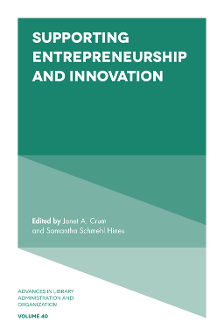
Index
Supporting Entrepreneurship and Innovation
ISBN: 978-1-78973-206-1, eISBN: 978-1-78973-205-4
ISSN: 0732-0671
Publication date: 29 April 2019
Citation
(2019), "Index", Supporting Entrepreneurship and Innovation (Advances in Library Administration and Organization, Vol. 40), Emerald Publishing Limited, Leeds, pp. 209-219. https://doi.org/10.1108/S0732-067120190000040014
Publisher
:Emerald Publishing Limited
Copyright © 2019 Emerald Publishing Limited
INDEX
- Prelims
- Introduction: Supporting Entrepreneurship and Innovation
- Part 1 Tools for Entrepreneurship and Innovation
- Not What You Expected: Implementing Design Thinking as a Leadership Practice
- Do Your Library Spaces Help Entrepreneurs? Space Planning for Boosting Creative Thinking
- Part 2 Library Activities Related to Entrepreneurship and Innovation
- Mission Statements, Innovation, and Academic Libraries: A Qualitative Study
- Academic Library Staffing Models in Support of the Entrepreneurship Ecosystem: An Examination of Case Studies
- Academic Libraries in 2018: A Comparison of Makerspaces within Academic Research Libraries
- New Partnerships for Ugandan University Libraries: A Shift from a Reactionary to Proactive Approach of Research and Innovation Information Services for SMEs
- The Status of Entrepreneurship in Libraries: Content Analysis and Assessment from the Conference for Entrepreneurial Librarians
- Part 3 Case Studies of Libraries Supporting Entrepreneurship and Innovation
- Innovation and Creativity: A New Facet of the Traditional Mission for University Libraries
- Creating Partnerships between Health Innovators and Librarians: A Story
- Part 4 Innovation and Entrepreneurship in Library Education
- Educating the Entrepreneurial Librarian
- From the Classroom to the Library: The Experience of Entrepreneurship and Teaching Innovation in the Area of Library and Information Science in Spain
- About the Authors
- Index